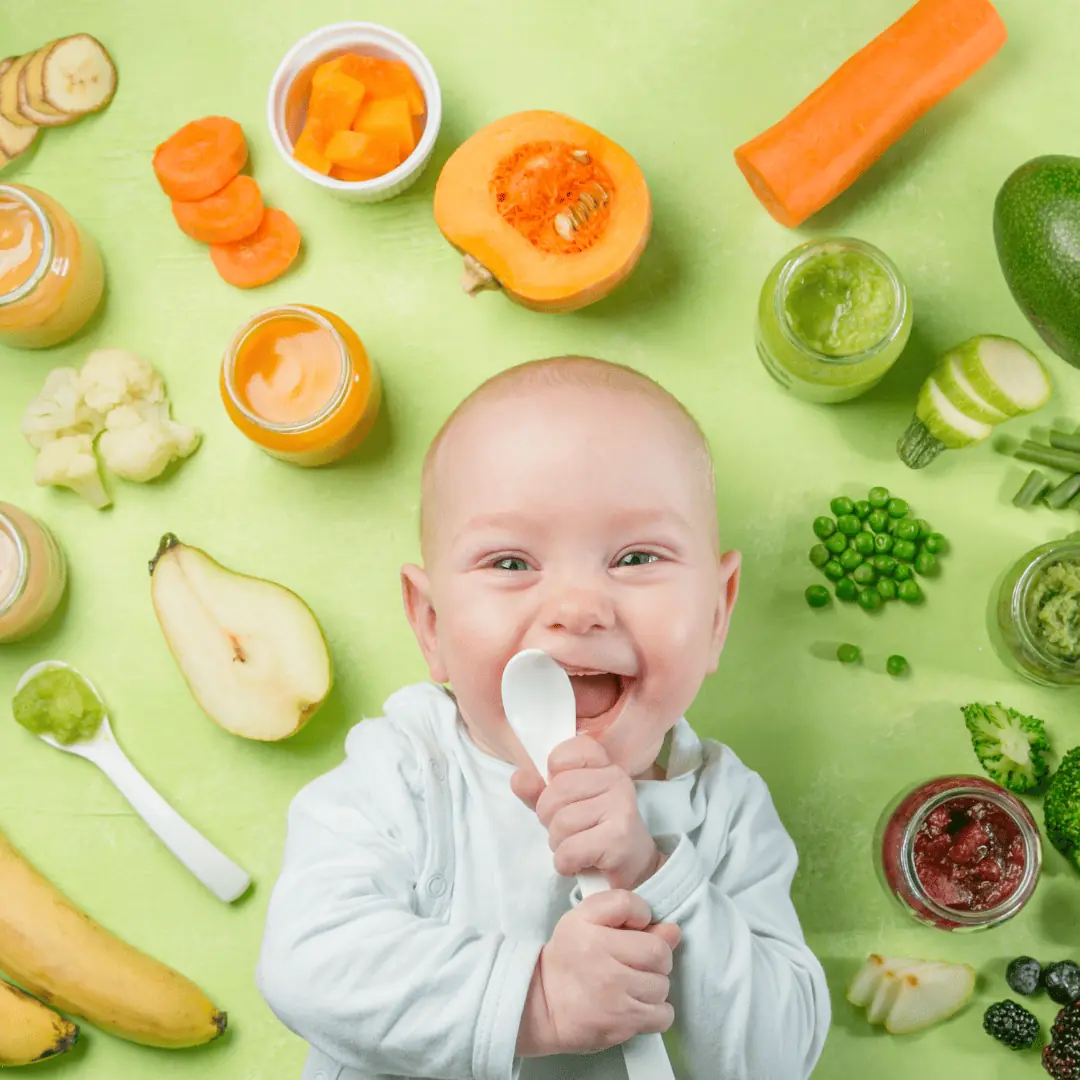Baby-Led Weaning Vs Purees: Which Is Better?
This post may contain affiliate links. As an Amazon Associate, I earn from qualifying purchases.
Deciding which is better between baby-led weaning vs purees may be a tough decision. Your baby is finally 6 months old (or older), and, although breastmilk is still sufficient to supply the nutrients required for proper growth and development, your baby is curious! It is time to choose a method to introduce solid foods to your baby.
Eating solid food is primarily a means for your baby to learn about different colors, textures, tastes, and flavors as they slowly transition away from breastmilk beyond 1 year.
You are not alone if you feel overwhelmed and confused about which method to choose.
Knowing the benefits and challenges of both baby-led weaning and purees early can help you choose the approach that will work best for you and your baby.
This article covers the differences between baby-led weaning and purees, the pros and cons of each, and my first-hand experience of using both feeding methods.
Editor’s note (JayDee): I love this topic! Of course, each baby is different. But, both my babies did baby-led weaning and loved it. People always ask me how I get my kids to eat everything (they will eat practically anything- most importantly the healthy stuff) and I credit it all to baby-led weaning and setting a good example (because they want to eat what you eat!). Babies build confidence and joy for eating when they are control and get to explore.
My experience with baby-led weaning vs purees
As a new mom, I had concerns about introducing solids. After months of eventually figuring out how to breastfeed my first child properly, the time for starting solids had come.
I went down the traditional weaning route, spoon-feeding my eldest son purees and the baby-led weaning approach with my second child. Both were positive experiences but had their pros and cons.
When my first son was 6 months old, I started feeding him purees made from steamed fruits or veggies and blending them with milk. We gradually progressed to mashed and later finger foods around 7 – 8 months.
It seemed straightforward at the time but preparing different purees was time-consuming. And I had made up my mind to prepare them at home and not choose store-bought ones as they were a bit pricey.
I felt good as a first-time mom, knowing how much my first son had eaten, and it was easier to ensure he was gaining the necessary nutrients.
For my second son, I decided to try a different approach. We started with baby-led weaning (BLW) when he turned 6 months. One advantage is that he could join in with family meals while feeding himself and making a mess. It was fun anyway, but I wondered if he was eating enough.
I offered him different finger foods at first, then he soon started eating what we all ate as a family. It saved me a lot of time preparing separate meals for him.
What exactly is baby-led weaning (BLW)?
Baby-led weaning or BLW means allowing your baby to feed themselves when the time comes to start eating solid food. Self-feeding encourages your baby to be independent and self-sufficient.
You should prepare bite-sized finger foods, typically by steaming them, until they are soft and easily squishable between their tiny fingers. This way, the food is easy for babies to hold and has a low risk of choking on them.
Also, you should cook with little or no salt because an infant’s body cannot process sodium well.
Once your baby has tried and tolerated several finger foods, you can start introducing combinations of different foods. Make sure they are nutrient-dense, giving your baby the appropriate nutrition to grow strong and healthy.
Examples of favorite baby-led weaning foods include:
- Ripe avocado
- Bananas
- Boiled egg
- Steamed sweet potatoes, broccoli, apples, cauliflower, carrots, and green beans
- Blueberries, strawberries, and raspberries
- Boiled chicken
- Plain yogurt
- Cooked beans
Purees
Purees are a traditional method of weaning babies and introducing them to eating solid foods. It involves spoon feeding your baby purees or even small bits of solid food, typically led by you or another adult.
Purees (cooked or uncooked fruit and vegetables blended to a soft, semi-liquid consistency) are easy starter foods for weaning babies to swallow, as the texture is smooth.
You may want to start by offering a single vegetable (such as a carrot) or single fruit (such as an apple) puree at each meal. In no time, your baby will be able to eat different fruits and veggies pureed together in more flavorsome combinations. Also, add protein in the form of cheese, lentils, meat, or fish.
Spoon-feeding babies pureed foods is a tried and tested method of gradually introducing them to different tastes and textures.
Parents can also graduate from making smooth purees and introduce other foods with soft lumps over the weeks. So their baby gets used to more textures.
Pros of baby-led weaning
May reduce the possibility of having a picky eater
Baby-led weaning allows your baby to eat foods with different tastes and textures at his own pace, which may help to reduce picky eating behaviors later on.
It is less time-consuming
Parents who allow their babies to self-feed can save time and even money.
You will not have to cook different foods for your baby because her meal consists of the same ingredients everyone eats.
There is also no extra cooking involved. And really, your baby can only eat a small quantity of food.
Strengthens motor skills
Baby-led weaning strengthens your baby’s muscles and develops her fine motor skills, manual dexterity, and chewing skills.
Baby does not have to miss family mealtimes
You can enjoy family mealtimes when your baby eats the same foods as everyone else and self-feeds. Your baby can also learn table manners by watching others eat.
Introduction to nutritious meals
Babies also need to eat a variety of foods to stay healthy. Baby-led weaning encourages parents to serve a balanced diet to meet their nutrition needs.
Cons of baby-led weaning
Mealtimes are a messy business
Parents prepare for a messy table with the baby-led method of weaning. Your baby is just developing her motor skills and has not mastered putting food in her mouth.
So handling foods and cutlery (although hands are best at first) will mean food will be all over the place, the floor, your clothes, your hair or baby’s, etc. This is what makes choosing the right high chair essential if you choose to use this method (think fewer nooks for food to get stuck in).
More foods will waste
Expect more food to go to waste in the early months because it will take a while for babies to figure out how to feed themselves. They are experimenting and exploring new flavors, textures, and colors. And mealtimes may also look like playtime, especially in the beginning (which is okay).
It will get better eventually.
It is difficult to determine how much food your baby is eating
Food tends to end up everywhere other than your baby’s mouth with baby-led weaning. Therefore, it can be tough to know exactly how much your baby is eating or if they are eating enough. With this method, you need to stay very tuned to your babies hunger cues.
Meeting nutrition needs
Since it is difficult to know what and how much food your baby is really eating. You can not always be sure your baby is getting enough nutrients.
Concerns about choking
Parents often worry about choking when their babies self-feed. So you should keep in mind the main food culprits that can cause choking and always cut them into small pieces to avoid it happening. Although, it’s also important to note that choking has not been found to be a higher risk with baby led weaning than with puree feeding.
Also, never leave children unsupervised while self-feeding. Thankfully, babies have a much stronger gag reflex than adults and spit out food from their mouths that is not going down the right way.
Pros of purees
Easier to keep track of how much your baby is eating
You have a clear idea of how much your child is eating at each meal. You can track her meals by the spoonfuls and how much of the puree in the bowl is left.
Also, it is easier to make sure your baby is getting the right amount of nutrients.
Less food wastage
Spoon-feeding your baby with purees reduces the quantity of food wasted and is less messy because you are in control of the feeding.
Easier to get family members on board
Any family member can feed your child purees with a spoon, allowing them to bond. You can also get other pressing things done.
RELATED READ: 6 WAYS TO GET DAD INVOLVED WITH YOUR NEW BABY
Cons of purees
It may be more expensive and time-consuming
It can take some time to prepare pureed foods and store them. Also, if you choose to buy already-prepared purees in jars, get ready to spend more- plus you won’t ever know exactly what’s in them. Commercially available purees may be more expensive, especially if you need to buy a variety.
Eating together as a family may be difficult
Family mealtimes may be difficult because you are feeding your baby while everyone else is eating. And if you have to coax your baby to eat her meal from a spoon, you may just excuse yourself from the table.
May increase the likelihood of picky eating in the future
Most purees are made up of a single food or a combination of two. Therefore, if your baby gets comfortable with one puree texture, it may be difficult for them to accept a new one, which increases the likelihood of picky eating.
Once your baby has no problem handling a smooth puree, introduce foods with more texture or purees with lumps.
How to choose which is better between baby-led weaning vs purees
There is no one correct way of introducing solids to babies. Weaning should be an enjoyable and positive experience for you and your baby and not a stressful event.
And you know what? You can easily combine both methods.
You can incorporate feeding your baby purees with a spoon while following the baby-led weaning method.
Preload a spoon with purees and let her spoon-feed herself. While your baby continues to explore different tastes and textures with her finger foods.
This allows your baby to lead the process and decide how much food she eats.
What matters more than deciding between baby-led weaning or traditional spoon-feeding when introducing solids is when babies are fed responsively.
Responsive feeding, or responding to a baby’s cue, involves:
- Watching your baby for signs of hunger and fullness at mealtimes
- Offering more food if your baby still seems hungry
- Allowing your baby to stop eating when she shows signs of fullness
Sounds easy, right? But guess what, your child’s appetite can change daily or even from one meal time to another.
This is actually quite normal. Children go through periodic growth spurts that influence their needs and appetite. You can trust your baby’s hunger and fullness cues as long as she gains a healthy weight and regularly fills her diapers.
RELATED READ: HEALTHY FAMILY MEALS FOR SUMMERTIME
Tips for any weaning method
Whether you choose to spoon-feed your baby with purees or go the baby-led weaning route, there are some things you should consider before starting solids.
- Your baby must be developmentally ready and can sit up with minimal support.
- Make sure you are always present to supervise your baby during mealtimes.
- Offer allergenic foods separately and in small amounts to your baby initially. If there is no allergic reaction, continue including it at least three times a week in your child’s food and in combinations with other foods.
Some examples of allergenic foods are:
- Cow’s milk
- Eggs
- Peanuts
- Soy
- Shellfish
- Wheat
- Prepare foods safely.
- Before feeding your child, check for hot spots in purees.
- Finger foods should always be soft with no choking potential.
- Do not add salt and sugar to your baby’s food.
- Do not give honey to a baby less than 12 months of age.
- Do not give babies unpasteurized dairy and undercooked eggs or meat.
- Avoid giving babies high mercury fish.
Final thoughts…
As a mom, choosing which method is better when weaning your baby, between baby-led weaning vs purees, or both, does not matter.
The goal is the same. Start solids when your baby is around 6 months (up to 12 months) and have them consume a nutritious family diet by around 12 months.
Every baby is different. For this reason, choose to do what is best and easiest for you.
Make weaning a relaxing and enjoyable time and watch your child grow strong and healthy.
What methods have you tried? Which do you prefer? We’d love to hear in the comments below!







